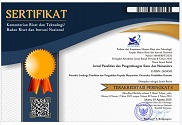Pengajaran Semantik pada Mahasiswa IKIP PGRI Pontianak
DOI:
https://doi.org/10.23887/jppsh.v4i1.24389Keywords:
Teaching, Seamntics, Relations of Meaning, Synonymy, AntonymyAbstract
This study aims to determine the process of semantic teaching in IKIP PGRI Pontianak students. The technique used in this research is direct observation and direct communication techniques. While the tools used are obesservation guidelines and interview guidelines. The processing and analyzing of the data is carried out through reflection activities. Data collected through essay test related to synonymy and antonym. The data analysis technique was carried out in stages (1) checking the result of observation carefully (2) determing the suitability of the formulation of learning objectives made by lecturers in teaching listening subject related to meaning relations (3) determing the suitability of the material with the learning objective 94) analyzing the suitability of learning activities conducted by the lecturer (5) Analysis of interview data by the lecture (6) The results of IKIP PGRI Pontianak student research in general can distinguish the relation of meaning related to synonymy and antonym.Downloads
Published
2020-04-21
Issue
Section
Articles
License
Authors who publish with the Jurnal Penelitian dan Pengembangan Sains dan Humaniora agree to the following terms:
- Authors retain copyright and grant the journal the right of first publication with the work simultaneously licensed under a Creative Commons Attribution License (CC BY-SA 4.0) that allows others to share the work with an acknowledgment of the work's authorship and initial publication in this journal.
- Authors are able to enter into separate, additional contractual arrangements for the non-exclusive distribution of the journal's published version of the work (e.g., post it to an institutional repository or publish it in a book), with an acknowledgment of its initial publication in this journal.
- Authors are permitted and encouraged to post their work online (e.g., in institutional repositories or on their website) prior to and during the submission process, as it can lead to productive exchanges, as well as earlier and greater citation of published work. (See The Effect of Open Access)









